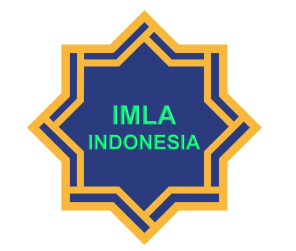Taṭwīr ʾAdawāt Ikhtibār Taʿlīm al-Ṣarf al-Muʿtamidah ʿalá Niẓām ʾAndrūyd: Dirāsah Taṭbīqīyah ʿalá Ṭalābat Maʿhad Dār al-Najāh al-ʾIslāmī
DOI:
https://doi.org/10.21580/alsina.6.1.23364Keywords:
Android-based assessment, educational technology, Arabic grammar, e-learningAbstract
Technological advancements have become vital in enhancing Arabic language education, particularly in assessing Arabic morphology learning at the Pondok Pesantren Daarun Najaah, where traditional methods lack innovation. This study develops "Kuis Shorof," an Android-based interactive assessment tool, driven by a needs analysis revealing the demand for digital media to improve student comprehension. Designed using Android Studio, the application includes 125 questions (35 multiple-choice, 35 true/false, 30 matching, 25 arranging) sourced from the Naẓm al-Maqṣūd textbook, featuring a user interface with cover pages, instructions, and results. Validation yielded a validity of 0.67 and reliability of 0.72, with questions rated "good" and "easy/medium," supported by expert evaluations (87% media, 95% content). Tested on 5 then 25 students, it achieved ratings of 83.73% and 88.64% ("very good"), with scores rising from 74.6 to 84.3 (13%) at statistical significance (t = -7.580, p < 0.05) and time efficiency (grading reduced to 5 minutes). Despite its benefits (interactivity, accessibility), limitations such as the absence of immediate feedback and a faulty back button necessitate improvements. Future enhancements, including AI integration, could broaden its educational impact.
Downloads
References
Azizah, Firdhany Nur, and Hamdan Husein Batubara. “Pengembangan Aplikasi Edukasi Kuis Bahasa Arab sebagai Alternatif Media Belajar Siswa Kelas I Madrasah Ibtidaiyah.” Alsina : Journal of Arabic Studies 3, no. 2 (2021): 219–40. https://doi.org/10.21580/alsina.3.2.8432.
Barrett, Neil E. et al. “Student Perceptions of a Mobile Learning Application for English Oral Presentations: The Case of EOPA.” Computer Assisted Language Learning 35, no. 9 (2022): 2476–2501. https://doi.org/10.1080/09588221.2021.1881975.
Black, Paul, and Dylan Wiliam. “Inside the Black Box: Raising Standards through Classroom Assessment.” Phi Delta Kappan 92, no. 1 (2010): 81–90. https://doi.org/10.1177/003172171009200119.
Branch, Robert Maribe. Instructional Design: The ADDIE Approach. Boston, MA: Springer US, 2009. https://doi.org/10.1007/978-0-387-09506-6.
Chen, Chih-Ming et al. “An English Vocabulary Learning App with Self-Regulated Learning Mechanism to Improve Learning Performance and Motivation.” Computer Assisted Language Learning 32, no. 3 (2019): 237–60. https://doi.org/10.1080/09588221.2018.1485708.
———. “Effects of a Mobile Game-Based English Vocabulary Learning App on Learners’ Perceptions and Learning Performance: A Case Study of Taiwanese EFL Learners.” ReCALL 31, no. 2 (2019): 170–88. https://doi.org/10.1017/S0958344018000228.
Clark, Ruth Colvin, and Richard E. Mayer, eds. E‐Learning and the Science of Instruction. Hoboken: Wiley, 2016. https://doi.org/10.1002/9781119239086.
Gamlo, Nada. “The Impact of Mobile Game-Based Language Learning Apps on EFL Learners’ Motivation.” English Language Teaching 12, no. 4 (2019): 49–56. https://doi.org/10.5539/elt.v12n4p49.
Ironsi, Chinaza Solomon. “Navigating Learners Towards Technology-Enhanced Learning During Post COVID-19 Semesters.” Trends in Neuroscience and Education 29 (2022): 100189. https://doi.org/10.1016/j.tine.2022.100189.
Kholis, Muhammad Nur, and Muhammad Fahrun Nadhif. “The Effectiveness of Quizlet.Com in Arabic Vocabulary Learning; Students’ Perception and Acceptance of Technology.” LISANIA: Journal of Arabic Education and Literature 7, no. 1 (2023): 1–13. https://doi.org/10.18326/lisania.v7i1.1-13.
Loewen, Shawn et al. “The Effectiveness of App‐Based Language Instruction for Developing Receptive Linguistic Knowledge and Oral Communicative Ability.” Foreign Language Annals 53, no. 2 (2020): 209–33. https://doi.org/10.1111/flan.12454.
Makruf, Imam. “Pemanfaatan Teknologi Informasi dan Komunikasi dalam Pembelajaran Bahasa Arab di Madrasah Aliyah Kabupaten Sukoharjo.” Arabi : Journal of Arabic Studies 5, no. 1 (2020): 79–90. https://doi.org/10.24865/ajas.v5i1.93.
Md Noor, Mohamad Lukman Al Hakim, and Muhammad Sabri Sahrir. “Difficulties of Learning Arabic Morphology, Reasons and Solutions, I’lãl and Ibdãl as an Example.” E-Jurnal Bahasa Dan Linguistik (e-JBL) 1, no. 1 (2019): 64–79. https://doi.org/10.53840/EJBL.V1I1.25.
Mizan, Ahmad Nur et al. “The Development of Arabic Learning Media Based on Android for Senior High School Students.” LISANIA: Journal of Arabic Education and Literature 6, no. 2 (2022): 178–89. https://doi.org/10.18326/lisania.v6i2.178-189.
Molenda, Michelle et al. “Designing Instructional System.” In The ASTD Training and Development Handbook, edited by R. L. Craig, 4th ed. New York: McGraw-Hill, 1996.
Nur, Aqida Miladia et al. “Taṭwīr Adawāt al-Taqwīm al-Takwīnī al-Qā’imah ʿalā Kahoot li-Tarqīyat Itqān al-Mufradāt fī Taʿlīm al-Lughah al-ʿArabīyah bil-Madrasah al-Mihanīyah.” Alsina : Journal of Arabic Studies 5, no. 2 (2023): 257–74. https://doi.org/10.21580/alsina.5.2.22933.
Raish, Michael. “Issues in Arabic Language Testing and Assessment.” In The Cambridge Handbook of Arabic Linguistics, edited by Karin Ryding and David Wilmsen, 83–105. Cambridge: Cambridge University Press, 2021. https://doi.org/10.1017/9781108277327.005.
Ratten, Vanessa. “The Post COVID-19 Pandemic Era: Changes in Teaching and Learning Methods for Management Educators.” The International Journal of Management Education 21, no. 2 (2023): 100777. https://doi.org/10.1016/j.ijme.2023.100777.
Rintaningrum, Ratna. “Technology Integration in English Language Teaching and Learning: Benefits and Challenges.” Cogent Education 10, no. 1 (2023): 1–12. https://doi.org/10.1080/2331186X.2022.2164690.
Ritonga, Mahyudin et al. “Utilizing Technology to Improve the Quality of Learning in Indonesia: Challenges and Consequences for Arabic Teachers.” Arabiyat : Jurnal Pendidikan Bahasa Arab Dan Kebahasaaraban 9, no. 1 (2022): 56–68. https://doi.org/10.15408/a.v9i1.24516.
Ryding, Karin C.. Teaching and Learning Arabic as a Foreign Language: A Guide for Teachers. Washington D.C.: Georgetown University Press, 2013.
Serostanova, Natalia. “Integrating Information and Communication Technologies in the Process of Foreign Language Teaching and Learning.” Journal of Education Culture and Society 5, no. 1 (2020): 187–97. https://doi.org/10.15503/jecs20141.187.197.
Sung, Yao-Ting et al. “How Effective Are Mobile Devices for Language Learning? A Meta-Analysis.” Educational Research Review 16 (2015): 68–84. https://doi.org/10.1016/j.edurev.2015.09.001.
Vygotsky, Lev Semyonovich. Mind in Society: Development of Higher Psychological Processes. Edited by Michael Cole, Vera Jolm-Steiner, Sylvia Scribner, and Ellen Souberman. Cambridge: Harvard University Press, 1980. https://doi.org/10.2307/j.ctvjf9vz4.
Zainuddin, Nurkhamimi et al. “Development of Arabic Language Lifelong Learning (A3L) Tutorial Platform Using WhatsApp Mobile Application.” Creative Education 11, no. 04 (2020): 452–67. https://doi.org/10.4236/ce.2020.114033.
Downloads
Published
How to Cite
Issue
Section
License
Copyright (c) 2024 Alsina : Journal of Arabic Studies

This work is licensed under a Creative Commons Attribution-NonCommercial-ShareAlike 4.0 International License.
Copyright
The copyright of the received article shall be assigned to the publisher of the journal. The intended copyright includes the right to publish the article in various forms (including reprints). The journal maintains the publishing rights to published articles. Authors are allowed to use their articles for any legal purposes deemed necessary without written permission from the journal, but with an acknowledgment to this journal of initial publication.
Licensing
In order for Alsina: Journal of Arabic Studies to publish and distribute research articles, the editors need publishing rights (transferred from author to publisher). This agreement relates to the transfer/publishing copyright license to Alsina: Journal of Arabic Studies but the authors still have significant rights to use and share their published articles.
Alsina: Journal of Arabic Studies supports the need for writers to share, disseminate and maximize the impact of their research and their rights on any database. As a journal article writer, you have the right to various uses of your articles, including that by the institution or company where you work. Copyright can be used without the need for special permission. Authors who publish articles in the Alsina: Journal of Arabic Studies have broad rights to use their work for teaching and scientific purposes without requesting permission, including:
- Use by the author for lectures, presentations, or conferences, with distribution of copies to participants;
- Distribution to colleagues for research use;
- Use in compilations of the author's subsequent work;
- inclusion in a thesis or dissertation;
- Reuse of sections or excerpts from articles in other works (with full acknowledgment of the final article);
- Preparation of derivative works (other than commercial purposes) (with full acknowledgment of the final article);
- Voluntary posting on open websites operated by authors’ or writers' agencies for scientific purposes
When submitting a manuscript, authors do so on the understanding that if accepted for publication, the copyright for publishing (publishing right) of the article shall be assigned/transferred to Alsina: Journal of Arabic Studies.
Authors whose articles are accepted for publication will receive confirmation via email and sent a Copyright Transfer Agreement.

 Accreditation
Accreditation 
 In Collaboration with
In Collaboration with 

 Visitors
Visitors  Article Template
Article Template





